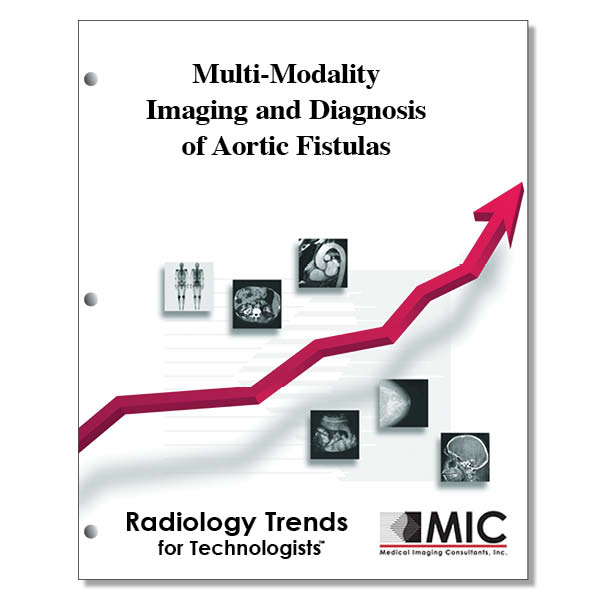

Multi-Modality Imaging and Diagnosis of Aortic Fistulas
The clinical and radiologic features of aortic fistulas are presented with focus on distinguishing fistulas from anatomic, postoperative, and pathologic mimics.
Course ID: Q00705 Category: Radiology Trends for Technologists Modalities: Cardiac Interventional, CT, MRI, Nuclear Cardiology, Nuclear Medicine, PET2.50 |
Satisfaction Guarantee |
$29.00
- Targeted CE
- Outline
- Objectives
Targeted CE per ARRT’s Discipline, Category, and Subcategory classification:
[Note: Discipline-specific Targeted CE credits may be less than the total Category A credits approved for this course.]
Computed Tomography: 2.50
Procedures: 2.50
Abdomen and Pelvis: 2.50
Magnetic Resonance Imaging: 0.50
Procedures: 0.50
Body: 0.50
Nuclear Medicine Technology: 0.50
Procedures: 0.50
Other Imaging Procedures: 0.50
Registered Radiologist Assistant: 2.50
Procedures: 2.50
Neurological, Vascular, and Lymphatic Sections: 2.50
Sonography: 0.50
Procedures: 0.50
Abdomen: 0.50
Vascular-Interventional Radiography: 0.50
Procedures: 0.50
Vascular Diagnostic Procedures: 0.50
Vascular Sonography: 0.50
Procedures: 0.50
Abdominal/Pelvic Vasculature: 0.50
Outline
- Introduction
- Pathogenesis of AoFs
- Spectrum of AoFs
- Radiologic Imaging
- CT Angiography
- Conventional Angiography
- MR Angiography
- Nuclear Imaging
- Ultrasonography
- Principal Imaging Features
- Aortoatrial Fistula
- Epidemiologic and Clinical Features
- Imaging Features
- Aortopulmonary Fistula
- Epidemiologic and Clinical Features
- Imaging Features
- Aortobronchial Fistula
- Epidemiologic and Clinical Features
- Imaging Features
- Aortoesophageal Fistula
- Epidemiologic and Clinical Features
- Imaging Features
- Aortoenteric Fistula
- Epidemiologic and Clinical Features
- Imaging Features
- Aortocaval Fistula
- Epidemiologic and Clinical Features
- Imaging Features
- Pitfalls
- Anatomic Mimics
- Postoperative Mimics
- Pathologic Mimics
- Treatment
- Conclusion
Objectives
Upon completion of this course, students will:
- recognize rare causes of aortic fistulas (AoFs)
- be familiar with CT angiography for diagnosing AoFs
- be familiar with the use of nuclear medicine for determining infections or slow intermittent bleeds
- be familiar with the definition of a true aneurysm
- be familiar with the pathophysiology of a secondary fistula
- be familiar with the morphologic subtypes of secondary AEFs
- recognize the risk factors for aorto-pulmonary fistulas
- be familiar with the entities that comprise the majority of clinically relevant AoFs
- be familiar with the concentration of IV contrast used on CT angiography
- be familiar with the advantages of using conventional angiography for detecting bleeds
- be familiar with the use of MR angiography for patients who cannot tolerate iodinated CT contrast material
- identify nitinol-based endografts
- be familiar with the use of 99mTc HMPAO for detecting infections
- be familiar with the use of 111In WBCs for detecting infections
- be familiar with the use of ultrasound for evaluating patients with AoFs
- be familiar with the primary cause of AAFs
- be familiar with the use of PET/CT for after recent aneurysm repair
- be familiar with the complications associated with AAF
- be familiar with the patient manifestations of AAF
- be familiar with APFs
- recognize the medical issues resulting from an APF
- be familiar with the use of echocardiography for evaluating AoFs
- be familiar with the childhood surgeries that may result in ABFs
- be familiar with the frequency of ABFs that are diagnosed at autopsy
- be familiar with AEsoFs
- be familiar with the manifestations of AEsoFs
- be familiar with the signs on CT associated with AEsoFs
- be familiar with AEFs
- be familiar with the manifestations of AEsoFs
- be familiar with the common manifestations for AEFs
- recognize the direct signs of AEF on CT angiography
- recognize the image findings of ACF on CT angiography
- be familiar with the anatomic variants of the aortic contour
- be familiar with the anatomy of the aortic nipple
- be familiar with the use of nuclear medicine for detecting subtle bleeds
- be familiar with infections that mimic fistula on CT
- be familiar with the pathologic processes that can simulate AoFs on CT imaging
- be familiar with Erdheim-Chester disease
- be familiar with open repair for AEFs
- be familiar with traditional reference standards for open repair
- be familiar with the complications of open repairs
- be familiar with AHA guidelines for treatment of AEsoFs
- be familiar with conservative approaches for treatment of small AAFs and ABFs
